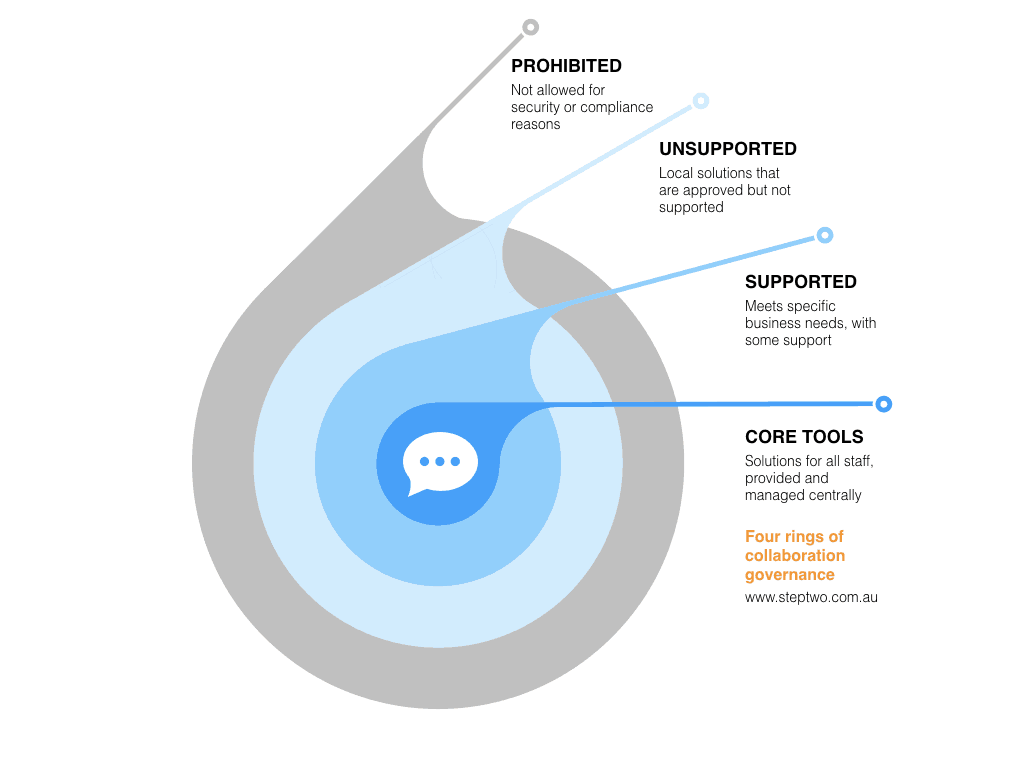
Filed under: Collaboration and social, Latest Features
The collaboration and social environment inside organisations isn’t getting any simpler. As discussed in the article Manage enterprise collaboration as a wicked problem, firms are increasingly getting “one of everything” when it comes to tools and platforms.
That’s to say, in addition to Office 365 or Workplace by Facebook, staff are also using Slack, Confluence, HipChat, Salesforce Chatter, Dropbox, WhatsApp and WeChat.
What’s needed is strong governance for collaboration and social within firms that works in the real world.
To that end, this article introduces a simple model: the four circles of collaboration governance. This is designed to maximise benefits, while targeting resources and managing risks.
What collaboration governance needs to do
Like every other ‘wicked problem’, there isn’t a single clear solution or way to control enterprise collaboration.
Collaboration governance still plays a role, however, in four key ways:
- improve staff success with collaboration and social tools
- ensure sustainability and manageability of collaboration solutions
- target corporate resources to have the greatest impact
- mitigate or avoid business risks
To achieve this, businesses need to make clear which tools staff should be using, what help they can expect, and what they shouldn’t be doing.
Four circles of collaboration governance
So you’re an internal comms or IT team tasked with ‘making governance a success’, but where do you start, and how do you make sense of the complexities?
The model shown above provides answers, as well as giving you something tangible that will align all the relevant collaboration stakeholders.
Starting from the inside circle, and working outwards:
- A core set of collaboration tools should be deployed or formalised. These are recognised as the ‘standard’ set of tools, and this is widely communicated so all staff understand their role. Corporate resources are then allocated to training, support, adoption and management to make these tools a success. (Typically core tools end up being provided by one of the major platforms such as Office 365, G Suite, IBM Connections or Workplace by Facebook.)
- A wider set of supported tools, that are used to meet either specific collaboration scenarios, or more targeted needs within particular business units. These tools are corporately recognised as useful, and they are provided with some support. This might take the form of community management and facilitation, rather than extensive training. (Examples of supported tools might include Salesforce Chatter for the sales team, Confluence and Jira for developers, and Box for secure sharing of documents with external partners.)
- Wider still are a sea of unsupported tools that are used for very specific or time-limited purposes. These tools are on the corporate radar, and have been endorsed as acceptable to use, but aren’t given any centralised support. (Examples might include collaboration tools for researchers and scientists, or tools provided by a joint venture partner.)
- Finally there are prohibited tools that represent significant business or reputational risks. While these tools are outside the boundary of acceptable solutions, care must be taken to ensure that staff have clear alternatives that are supported. (Examples might be using public Facebook groups for team discussions, or WeChat for sharing customer information.)
Less is more, and clarity is king
There is a long journey ahead before firms have truly mastered the art of enterprise collaboration. While there are many steps that must be taken on multiple fronts, immediate benefits come from providing clarity about where all the many tools fit in, outlining what should be used, and what shouldn’t.
With limited resources to allocate to supporting collaboration and social tools, targeting a small set of core tools is a practical and pragmatic step. The wider circles of supported and unsupported tools can then shed light on the grey area that contains dozens of different tools and needs.
With a shared vision of collaboration governance across all stakeholders, we can then start to take more confident steps to make collaboration work.






